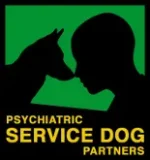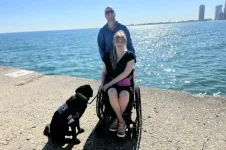BY JUSTIN SURETTE
Your four-legged companion will have minimal issues getting onboard.
While it can be challenging, many airlines allow passengers to take their furry friends with them onboard. Whether you're bringing a small pet onboard or traveling with a larger companion in the cargo hold, there's a good chance your carrier of choice will help you facilitate traveling with your non-human family member. But do the rules change when it comes specifically to service dogs? At least in the United States, the Department of Transportation (DOT) has clearly defined rules for what airlines must accept regarding working dogs.
What defines a "Service Animal"
According to the Air Carrier Access Act (ACAA), a service animal refers to a dog that is individually trained to do work or perform tasks for an individual with a disability, including a physical, sensory, psychiatric, intellectual, or other mental disability. This may be a dog sensing their diabetic human's blood pressure is reaching a critical level, reminding someone with depression to take their medicine, or helping someone with epilepsy remain safe during a seizure.
Undoubtedly, many people have found help from an Emotional Support Animal (ESA). However, to enforce regulations, ESAs, even if they are dogs, might not count as Psychiatric Service Dogs (PSD). As explained by Trips To Discover and the Americans with Disabilities Act (ADA),
And specifically, when it comes to flying, the DOT has ruled that only dogs will count as such service animals. That said, there are no restrictions on breed or size, and airlines can freely choose to allow other animals if they like, but at the bare minimum, they must accept service dogs for transport with the individual they serve.
Rules surrounding flying with service dogs
Again, as long as they have been trained to assist someone living with a disability, the breed of dog does not matter, even those seen as more naturally aggressive. And while non-service animals typically must fit in your lap or underneath the seat in front of you, service dogs are mostly excluded from this rule, with mild discretion allowed by the airline.
Bringing a Great Dane or a large Husky onboard would be difficult. But the ACAA says that as long as there's an empty seat in the same service class on a flight, it goes to the service dog. That may mean a seat rearrangement to ensure the dog has enough space to lie down between the empty seat and the owner's lap or on the ground in that space.
Owners could instead purchase an extra seat next to them for their dog instead of gambling on an empty space; if the flight is full, the passenger may be given a choice between their dog riding in the cargo hold (as is common with large non-service animals) or being bumped to a later flight that does have an extra seat onboard. Assuming you've made your way onboard with your service companion, remember to have a leash or some way to tether them, as airlines are allowed to enforce such a rule.
As with all rules, there are exceptions. If a service dog creates a significant disruption at the airport or poses a health risk to other passengers, the airline can deny transport. Also, carriers can request specific documents, such as the DOT's Service Animal Air Transportation Form or Service Animal Relief Attestation Form. And, if you're traveling internationally, it is the owner's responsibility to ensure their service dog can gain entrance to the foreign nation.
Get the latest aviation news straight to your inbox: Sign up for our newsletters today!
It's worth mentioning that, although airlines (or businesses in general) can't require a passenger to explain their disability, they are allowed to ask two specific questions about service dogs: "Is the animal a service animal required because of a disability? What work or task has the animal been trained to perform?" Owners should be ready to answer these questions.
Your four-legged companion will have minimal issues getting onboard.
While it can be challenging, many airlines allow passengers to take their furry friends with them onboard. Whether you're bringing a small pet onboard or traveling with a larger companion in the cargo hold, there's a good chance your carrier of choice will help you facilitate traveling with your non-human family member. But do the rules change when it comes specifically to service dogs? At least in the United States, the Department of Transportation (DOT) has clearly defined rules for what airlines must accept regarding working dogs.
What defines a "Service Animal"
According to the Air Carrier Access Act (ACAA), a service animal refers to a dog that is individually trained to do work or perform tasks for an individual with a disability, including a physical, sensory, psychiatric, intellectual, or other mental disability. This may be a dog sensing their diabetic human's blood pressure is reaching a critical level, reminding someone with depression to take their medicine, or helping someone with epilepsy remain safe during a seizure.
Undoubtedly, many people have found help from an Emotional Support Animal (ESA). However, to enforce regulations, ESAs, even if they are dogs, might not count as Psychiatric Service Dogs (PSD). As explained by Trips To Discover and the Americans with Disabilities Act (ADA),
And specifically, when it comes to flying, the DOT has ruled that only dogs will count as such service animals. That said, there are no restrictions on breed or size, and airlines can freely choose to allow other animals if they like, but at the bare minimum, they must accept service dogs for transport with the individual they serve.
Rules surrounding flying with service dogs
Again, as long as they have been trained to assist someone living with a disability, the breed of dog does not matter, even those seen as more naturally aggressive. And while non-service animals typically must fit in your lap or underneath the seat in front of you, service dogs are mostly excluded from this rule, with mild discretion allowed by the airline.
Bringing a Great Dane or a large Husky onboard would be difficult. But the ACAA says that as long as there's an empty seat in the same service class on a flight, it goes to the service dog. That may mean a seat rearrangement to ensure the dog has enough space to lie down between the empty seat and the owner's lap or on the ground in that space.
Owners could instead purchase an extra seat next to them for their dog instead of gambling on an empty space; if the flight is full, the passenger may be given a choice between their dog riding in the cargo hold (as is common with large non-service animals) or being bumped to a later flight that does have an extra seat onboard. Assuming you've made your way onboard with your service companion, remember to have a leash or some way to tether them, as airlines are allowed to enforce such a rule.
As with all rules, there are exceptions. If a service dog creates a significant disruption at the airport or poses a health risk to other passengers, the airline can deny transport. Also, carriers can request specific documents, such as the DOT's Service Animal Air Transportation Form or Service Animal Relief Attestation Form. And, if you're traveling internationally, it is the owner's responsibility to ensure their service dog can gain entrance to the foreign nation.
Get the latest aviation news straight to your inbox: Sign up for our newsletters today!
It's worth mentioning that, although airlines (or businesses in general) can't require a passenger to explain their disability, they are allowed to ask two specific questions about service dogs: "Is the animal a service animal required because of a disability? What work or task has the animal been trained to perform?" Owners should be ready to answer these questions.















